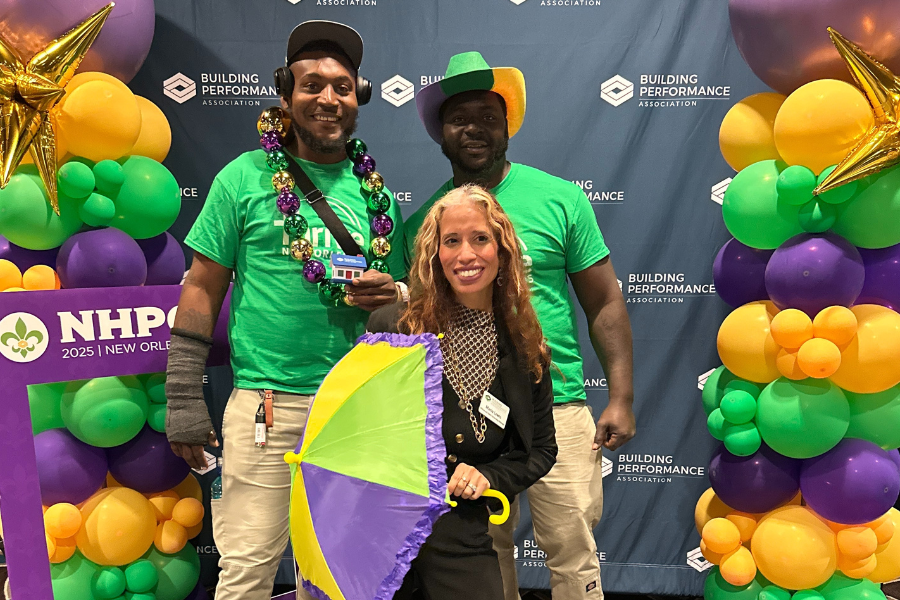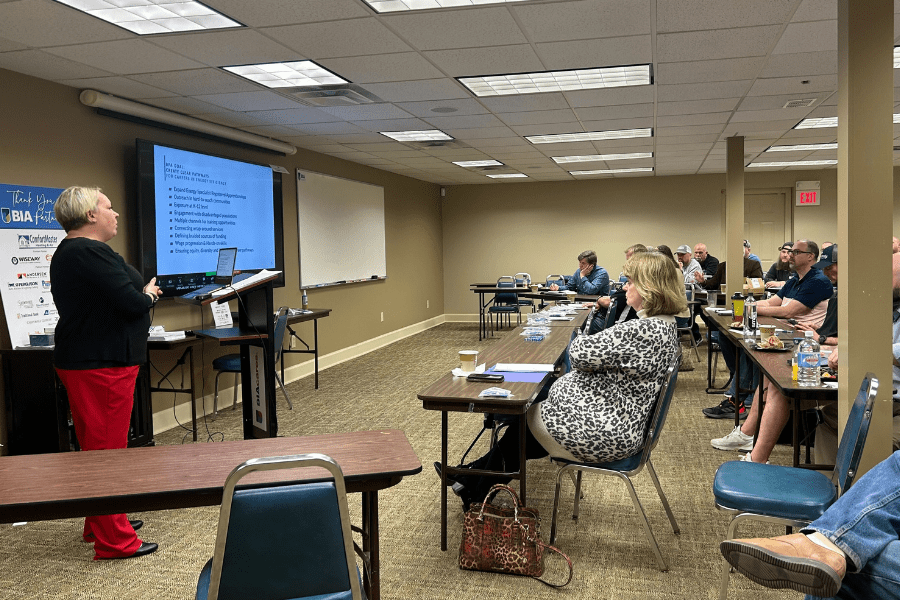Mar 21, 2022
Let’s Talk Gender: What Women Bring to Home Performance
In honor of Women's History Month, the author takes a look at their archives to see what they have published about women in home performance. The article "Let's Talk Gender: What Women Bring to Home Performance," published in 2014, discussed the most common gender-specific obstacles that women face in the industry, which were proving themselves, meeting the physical demands of the job, and lack of support or mentorship. The article also highlights the Women in Home Performance initiative, which aims to remove barriers, promote opportunities, and offer networking and mentorship to women in the traditionally male-dominated industry. Sharing stories among women in the industry is seen as an important way to encourage and support each other.
By: Macie Melendez

In honor of Women’s History Month, we’re taking a look at our archives—specifically at content we’ve published related to women’s in-home performance. If you’ve missed them, we’ve already published two articles this month: “The XX Factor” and “Women Undervaluing Themselves.” This week, we’re re-publishing “Let’s Talk Gender: What Women Bring to Home Performance.” I wrote this article in 2014…has anything changed since then?
Let’s Talk Gender: What Women Bring to Home Performance
It’s no secret that home performance is a male-dominated industry. Attend any industry conference and you’ll quickly see that women are vastly outnumbered. That being said, there are still women in the industry—and those women certainly hold their own.
Nearly two years ago, I attended a regional ACI event in Sacramento and sat in a room where the Women in Home Performance initiative was in its infancy. The leaders of the discussion asked the women, and men, in the room why they had decided to attend a meeting about women in home performance. Because the initiative was new, it was still defining itself, and its founders wanted to ensure that they were giving people who were interested everything they wanted from this group. The answers given weren’t surprising; they included finding support, making sure women have a place at the table, to network, receiving nurturing, and to share stories.
ACI’s Women in Home Performance initiative is now much more defined. It “aims to address challenges, remove barriers, and promote opportunities for women in the traditionally male-populated home performance and weatherization industry.” The initiative also offers a forum for business development, education, mentoring, and networking.
But in my opinion, it’s the storytelling among women in our industry that harnesses the most power to encourage and support us. The more we share with one another, the more we can learn from one another, and the better we can all become at what we do.
With that in mind, I set out to discover what the most common gender-specific obstacles to jobs in home performance were by asking women to describe the biggest obstacles they have faced since they entered the field. I posed the question to several colleagues and posted it on Home Energy’s social media sites, which include approximately 13,000 Twitter followers and 700 Facebook friends. There were a lot of responses and some definite trends. According to the answers I received, the three most common obstacles women face in our industry are proving themselves, meeting the physical demands of the job, and lack of support or mentorship.
Prove Yourself
Much as I’d like to believe that we’ve evolved as a society, the fact remains that some people simply don’t trust women who are doing what they’ve deemed to be a “man’s job.” Home performance is one of those jobs, because it involves both science and physical labor, not unlike plumbing or electrical work. Unfortunately, this means that women in home performance still have to prove themselves to their customers before they earn their trust.
Getting Through the Door

“I’ve faced the situation where the customer was taken aback by a woman walking through the door,” says Mary Tchamkina, program associate at Enterprise Community Partners. “It helps enormously to have information on the tech side of things. You have to prove yourself before someone says, ‘Okay, this is for real.’”
Having knowledge in the field is one surefire way to exude confidence—a helpful tool to have in any situation. “Once in a while, even today, someone will answer my knock at the door and look behind me for another auditor who can help me with the audit,” says Mickey Souza, owner/principal of Energineers. “Because I believe in myself and know how much effort I have put into learning how to be a proficient auditor, I know that I can provide a customer with a unique and new perspective on their home. Being a woman has nothing to do with how good an audit I can perform.”
By and large, having the knowledge, skills, and abilities to back up your work is the best way to quickly change a customer’s mind—a customer who has preconceived notions of what an energy consultant or home performance auditor should look like. But Mina Agarabi, a mechanical engineer who recently started her own independent consulting firm, says that you have to handle your knowledge appropriately or it too can be misconstrued. “When you’re asking questions, people can get a little defensive if you talk too technically and too direct because they feel like you’re trying to be some young girl who thinks she knows everything. People think you’re trying to change the way they do things and they get defensive. This also happens with male contractors, especially the ones who ‘have been doing this for 50 years!’” she says.
Melissa Abdo, the managing director of Pro Energy Consultants, agrees. “I would say the biggest obstacle stems from an old preconceived idea that women, in general, are not interested in understanding how the systems in a home should work together for improved efficiency.” It’s likely that those biased notions can only be changed with a strength-in-numbers approach. As more women enter a home performance, they’ll be able to change the minds of both customers and contractors. The good news, says Abdo, is that “we are seeing women play an increased role in the home performance market, both as consumers and as service providers.”
Appearance
Once women get past the customer’s door, there are additional obstacles to be overcome. One of them is making sure that their physical appearance matches the professionalism and ambition they have for the job. “I have to wear certain clothing to make sure I’m taken seriously,” says Agarabi.
This issue isn’t necessarily specific to home performance; however, it does raise the question of safety for women who are entering homes, especially if they’re doing so alone. “I’ve had numerous people flirting and asking me to go out and get coffee and being inappropriate during an audit,” says Agarabi, who handles these situations with as much professionalism as possible. When a customer doesn’t treat her with the respect she deserves as a professional, she confidently explains to them her skills and maintains a dignified demeanor.
Stereotypes
Just as appearances tell your story for you, so can your attitude. “Outspoken, powerful women are viewed as bitches, pushy, out of their league, and emotional,” says A. Tamasin Sterner, president and chief coach of Pure Energy Coach LLC. But in her 33 years as an energy auditor, Sterner has rarely felt pressure from these stereotypes—until recently.
Pure Energy Coach LLC is primarily a quality assurance/quality control firm that performs third-party inspections on completed utility low-income program residential energy retrofits. Quality control inspection reports involve reporting situations, materials, and installations that don’t meet program standards. “A value-added benefit to our inspections is feedback—a narrative about what the contractor could have done to meet standards, and our thoughts on how the contractor made their decisions to do what they did that resulted in a failed job. Our intent has always been to make every inspection an opportunity to teach, and this has worked well for decades,” says Sterner.
Recently, however, she came across one program manager who doesn’t value her company’s feedback. “He interprets our feedback as ‘opinions and feelings’ and actually told me that ‘feelings are not appropriate in the program,’” she says. In fact, Sterner’s company has received awards for its objective, factual feedback. “I honestly believe that the male utility manager is listening to Pure Energy’s feedback differently because the company is woman-owned, and he must have a problem with powerful women. I can usually handle this. However, when a person’s personal biases regarding gender get in the way of a contract being awarded, it’s a problem.”
Solutions

Yes, you are a woman. And yes, you’re sometimes going to have to prove yourself because of that fact, but the best way to do that is to let your skills shine through. Prove yourself through your knowledge and training. “I’m sure I’ve had to face many obstacles, but due to my determination, focus, and desire, and my love for the industry and our customers, I’ve either pooh-poohed the obstacle or taken it on as a challenge,” says Sterner.
Comedy is another option when dealing with people who give in to gender stereotypes. “I’ve learned to deal with these obstacles through humor,” says Tchamkina. “It’s a good way to disarm someone with a prejudice without antagonizing them.” Sterner also values humor. She tells her customers, “As Bob Thaves, who drew the comic strip ‘Frank and Earnest,’ famously said about Fred Astaire: ‘Sure, he was great, but don’t forget Ginger Rogers did everything he did, backward. . . and in high heels.’”
Amy Beley, the senior project associate at Build It Green, says she’s often felt as if she can’t be herself in this male-dominated industry, but she’s learned to develop tougher skin. “It’s taken me a while to recognize that many men in this industry are simply unaware of how best to interact with up-and-coming women. As I’ve found my bearings in the industry, I’ve learned that a little education goes a long way. Some of my closest friends in the industry are men, and our ability to have candid, open conversations about the gender disparity is very heartening.”
The Intimidation Issue
Many home performance jobs are physically demanding, which can be intimidating. While some women simply aren’t able to perform the job duties required in energy audits, some just assume they won’t be able to handle it.
Don Lovell, the owner of Energy Upgrade Services, says that we don’t see a lot of women in the field because it is brutally hard work. “The truth is that a lot of boys and men don’t last either. I started out as a 14-year-old crawling around in attics and installing ductwork. It was miserable,” he says.
Agarabi says that when she finished her certifications to join the industry, she didn’t necessarily feel qualified. “In my opinion, you aren’t actually qualified to do the work if you have no hands-on experience. I think for some people that can be intimidating, especially in a boiler room with dirty, loud equipment.”
Of course, there are other people who physically cannot do the work required. Jayne Windham of Housing Compliance Solutions LLC was one of them. “It’s likely related to my being a small human, not just a small woman, but my biggest obstacle has been big obstacles,” she says. “The tools and equipment are sized for larger workers and are often heavy. The fan for the blower door was particularly problematic for me.” She says that she managed to learn how to handle the equipment and demonstrate it, but she would not have been able to meet the physical demands of the job on a long-term basis. “But being small has its advantages too,” says Sterner. “Getting into attics and other small spaces often takes a small person.”
The science behind home performance can be equally overwhelming. “Engineering, math, and science seem intimidating to some women, especially the ones who studied humanities or something else, but it’s not,” says Karen Butterfield, managing director of national and federal accounts at SunPower Corporation. “Engineers need people who can explain things. If you ask 100 questions, you will get it in a way that the engineer may not even get. This is powerful.”
Overcoming Intimidation
There’s no doubt that climbing into crawl spaces and carrying heavy tools isn’t for every woman. But if home performance is where your heart is, then the determined woman can make it happen. You have to want to do the job, and if it’s not for you, you can also be involved in other areas, such as research or administration, for example. “Of course, one needs to be physically fit to climb around in attics and crawl spaces, but even today, I can outlast some men who are half my age,” says Souza. Sterner adds, “Loving what you do gives you the energy and power to do it.”
Mentorship

Lack of support and mentorship is another common obstacle for women in home performance. While groups, such as ACI’s Women in Home Performance initiative, have been formed in recent years, it’s an industry that’s been around for decades without any outright support for women.
“There’s limited support networks for this work and no mentor/mentee setups that I know of,” says Agarabi. For her, “finding a mentor has been challenging and slow.” Agarabi has had so much trouble finding a home performance mentor, in fact, that she’s sought out advice and mentorship from a businesswoman in another industry. Since she’s thinking of starting her own business, it’s been helpful, but it doesn’t bode well for our industry if women can’t find other women, or men for that matter, to mentor them and help them along the way. (See the Q&A boxes for advice from established women in the industry.)
Finding Support
It may not be easy, but if you crave mentorship, then don’t give up. There are people out there who can and want to help. Reach out to professional organizations and communicate with peers via social networks such as Home Energy Pros and ACI’s Women in Home Performance LinkedIn Group.
Mentorship may be easier to find in some states than in others. “I feel like I have been fortunate to have tapped into a great community of green-building aficionados in New York City,” says Tchamkina. “Through volunteering and becoming involved with professional organizations, I have been able to find amazing mentors—mostly men—who have guided me, tutored me in technical matters and helped me make the right connections. I also found a community of women who find themselves in similar roles and similar points in their careers. I would say in New York City in particular, organizations like NESEA [Northeast Sustainable Energy Association] and GreenHomeNYC are instrumental in promoting the role of women in the green-building industry.”
No matter what level of support you feel you need, it’s important to network with peers. “Above all, don’t try this on your own. Most successful people want to help others succeed because they had help along the way,” says Souza. “Let people know your dreams and how they can help be a part of them.”
This article originally appeared in Home Energy magazine, which is the eJournal’s predecessor publication. We’ll be publishing more women in-home performance content throughout this month





